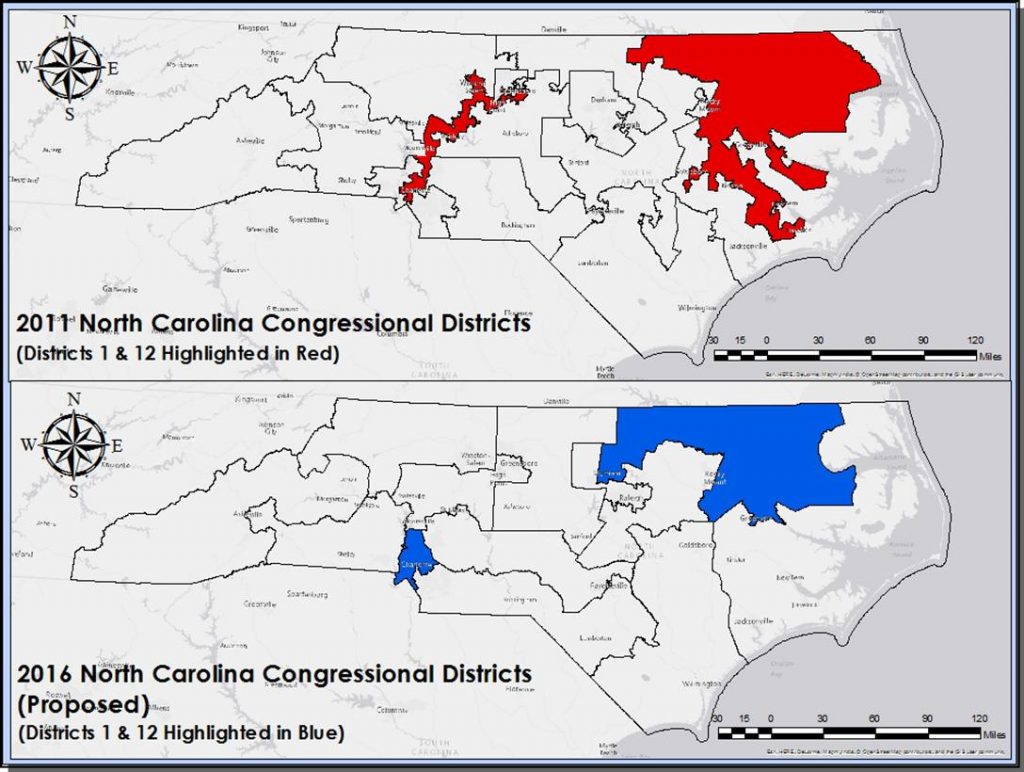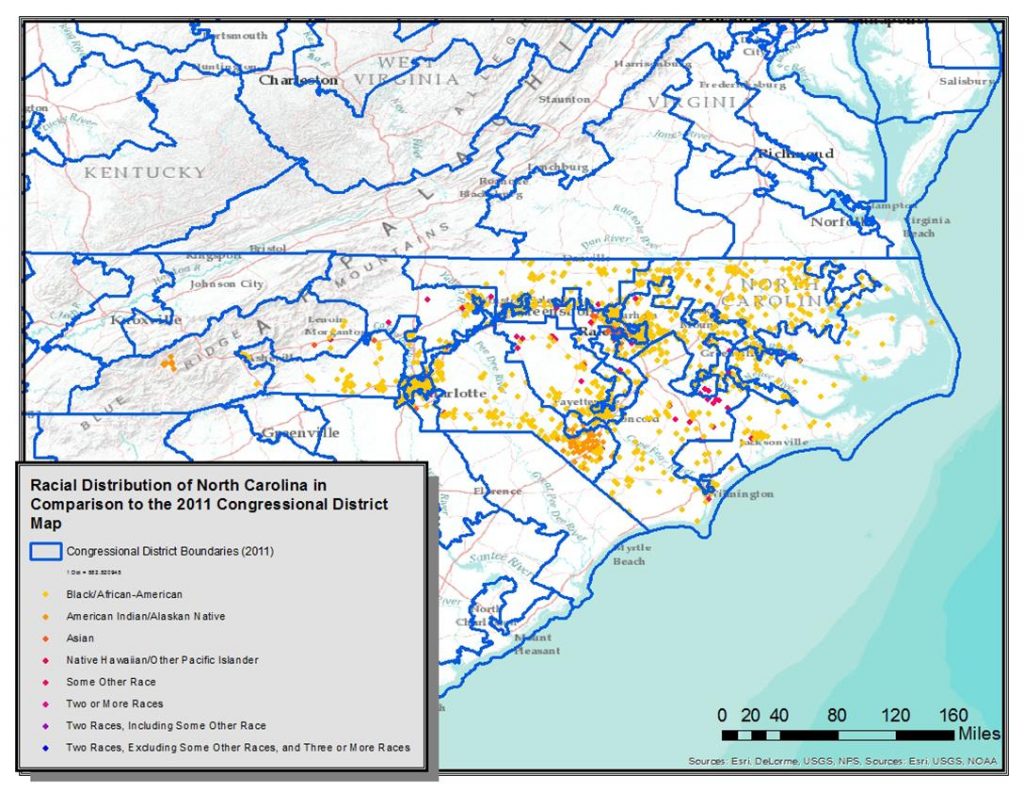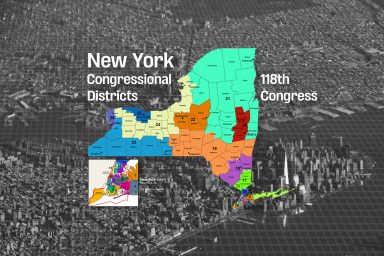How North Carolina’s Republicans Are Fighting Democracy
Is North Carolina a Preview of What’s to Come?
Whether through gerrymandering, voter ID laws, or gubernatorial restrictions, North Carolina has become ground-zero for Republican led voter suppression.
A war is heating up in North Carolina about the right to vote, and the political future of the state. The Wake County Superior Court found recently that the Republican-controlled General Assembly’s “power grab” last December to strip the incoming Democratic governor of his authority was unconstitutional, violating the state’s strictly defined separation of powers.
The ruling overturned the General Assembly’s plans to force the new governor to keep appointed holdovers from the former governor, Republican Pat McCrory, and it struck down the Republicans’ plans for restructuring the State Board of Elections (SBE).
The Republicans intended for the SBE to no longer have a majority of its members — at either the state or county level — belong to the governor’s party, for all decisions to be decided by supermajority consent, and, essentially, for Republicans to head the state and county boards on election years.
The election of a Democratic governor last year directly challenged the ability of the Republican-controlled General Assembly to defend a suite of voter disenfranchisement tactics that has been called a “monster law.”
For traditionally purple North Carolina, this fight represents a willingness by the GOP to abandon any vestige of bipartisanship in accepting the will of the electorate.
One can argue that the roadmap for the national Republicans to permanently consolidate power is being tried out in North Carolina — particularly in light of calls by the president to investigate alleged voter fraud.
By 2055, the United States will be far more ethnically diverse; no single race will make up more than 50 percent of the population. The country also is growing more liberal by the year, placing increasing pressure on conservatives to find ways to “stay at the table.” Many politicians have embraced undemocratic tactics in order to stay in power.
“The right to vote is our most fundamental right,” said North Carolina Attorney General Josh Stein, who, in February, filed a motion with the U.S. Supreme Court to dismiss the petition to appeal the overturning of the 2013 voting restrictions package.
The NC General Assembly has responded to this call with a petition of its own to the Supreme Court, seeking to disqualify Stein from the case.
“Voting is how people hold their government accountable,” said Stein in comments regarding his decision to drop the case. “I support efforts to guarantee fair and honest elections, but those efforts should not be used as an excuse to make it harder for people to vote.”
While the situation in North Carolina can be construed as a consequence of the hollowing of the Voting Rights Act, the North Carolina case is really a study in gerrymandering and how this “winners-take-all” approach to governance has managed to turn a demographically purple state into one that is solidly red. It is also a warning to the rest of the nation that — left unchecked — aggressive gerrymandering can, and will, be the end of American democracy.

Ten of thousands protested the extreme actions of the Republican North Carolina government at the capitol building in Raleigh.
Photo credit: James Willamor / Flickr (CC BY-SA 2.0)
North Carolina NAACP v. McCrory
.
Looking at North Carolina in the six years since the GOP took over the General Assembly shows a ratcheting up of political gamesmanship towards party identity politics and away from popular opinion. A short list of the items passed or considered by the General Assembly to ensure or protect Republican power includes, but is not limited to:
• A rollback of the incoming Democratic governor’s powers prior to his taking office, including a cut in the politically appointed offices the governor controls by two-thirds; denying the governor’s party the majority on the State Board of Elections and the subsidiary county offices, with Republicans chairing the board on election years; stripping the governor the right to appoint trustees to the University of North Carolina’s board of governors and requiring General Assembly’s consent and confirmation for secretary-level Cabinet positions (this was done in an emergency session after Republican former-governor Patrick McCrory conceded his defeat to current-governor Roy Cooper);
• Requiring a state or federal-issued photo ID to be shown to a county’s board of election for a provisional ballot to be counted and banning university IDs (including IDs from the University of North Carolina, which is a state agency);
• Making the public education requirement for a state-issued voter ID not mandatory;
• An amendment to the state’s constitution to ban civil unions and gay marriage, statewide;
• The adding of two seats to the North Carolina Supreme Court that would have been appointed by then-outgoing governor McCrory with the expressed purpose of breaking the Democratic 4-3 control of the court (the proposal fell through);
• Initiating a voter registration purge in every county of the state, which unequivocally targeted black, Latino, and poor voters that may not have regular access to at-home mail delivery;
• Passing HB 100, which would make races for state trial judges — including those for the state’s Supreme Court and the Court of Appeals — partisan and no longer subject to gubernatorial appointment;
• Expanding the jurisdiction of the Republican-controlled NC Court of Appeals and adding new requirements and delays for granting appeals in specific cases, such as challenges to the state constitution or the redistricting maps;
• Combining the State Board of Elections with the state’s lobbyist regulation office and Ethics Commission without adding any new monies to handle the increased workflow;
• Requiring tenured professors with the University of North Carolina to declare their political affiliation so that the political complexion of the teaching staff “matches” that of the state; and
• A move to end nonpartisan elections for down-ballot races and political appointments, including those of municipal school board, the State Board of Elections, local judges, and town councils.
The most odious of this legislation, however, centers on voter disenfranchisement.
The fight over voting rights in North Carolina can be defined by two important court battles. The first of these cases is North Carolina NAACP v. McCrory, where the state chapter of the nation’s oldest advocate for racial equality challenged North Carolina HB 589 on the grounds it violated Section 2 of the Voting Rights Act and the Fourteenth and Fifteenth Amendments of the United States Constitution.
Introduced shortly after the Republicans took the General Assembly and the Governorship for the first time in 100 years in 2013, HB 589 sought to limit potential Democratic voter turnout by incorporating many of the voting disenfranchisement ideas that other Republican statehouses were considering into one bill. HB 589 eliminated a full week from early voting, got rid of same-day registration, banned pre-registration of 16 and 17-year-olds and the counting of out-of-precinct provisional ballots, and pushed through a strict voter identification requirement. It was accompanied by other bills that strengthened poll observers’ privileges, eliminated weekend voting, and struck-down straight-ticket voting. In other words, the law made it more difficult for minorities to vote.
This voter ID requirement forced registered voters to sign an authorization form, which warned voters “fraudulently or falsely completing this form is a Class I Felony,” and to show a Help America Vote Act-compliant proof of identity when registering that shows an address with the voter’s name and address. Their restrictions were coupled with a nationwide effort by Republican lawmakers to eliminate 868 polling places, including 27 in North Carolina alone.
According to a 2013 Democracy North Carolina analysis, 55% of registered North Carolina voters who do not have a state-issued photo ID are Democrats, compared to 21% Republicans.
These efforts run counter to the bipartisan co-existence that has defined North Carolinian politics in the past.
“Since the 70s and 80s, North Carolina has been a growing two-party state,” Bryan Warner, director of communications for Common Cause North Carolina, told WhoWhatWhy. “It was previously exclusively Democrat, as was the case for most Southern states, but post-Nixon, the Republicans started to make gains in the state. But, a complete Republican takeover never happened in North Carolina before 2010, with the Democrats and Republicans typically sharing power, 50-50.”
Warner pointed out that the 2008 historic election of Barack Obama and the 2006 and 2008 Democratic electoral sweeps both mobilized the Republicans for the 2010 midterms and led the Democrats into a false sense of complacency. This allowed the Republicans, despite having fewer registered voters, to take control of a majority of the state houses in 2010 — just in time for the 2010 Decennial Census and the 2011 Congressional Redistricting.
The Problem with Gerrymandering
.
On the surface, the Republicans taking the General Assembly in 2011 should not raise any major red flags. While the Republicans did control both chambers, they did not have the supermajority they would have had in 2013. Furthermore, Democratic governor Beverly Perdue was still in power. Perdue vetoed or blocked attempts to strike Sunday voting, eliminate early voting entirely, regulating or blocking voter registration drives, and requiring photo ID for registration and voting.

Differences between the 2011 congressional district map and the proposed 2016 district map.
Photo credit: Visualization: ESRI/ArcGIS; Data: North Carolina General Assembly
North Carolina is unique, however, due to the fact that the legislature can approve redistricting maps without the governor’s consent. This gave the Republican General Assembly a free hand to draft the 2011 district maps.
The Republican General Assembly attempted to put in place several provisions that would suppress minority votes. For the most part, they were blocked or Perdue vetoed them. However, the election of Patrick McCrory and the establishment of a GOP supermajority in the General Assembly in 2012 gave the Republicans an opportunity to implement their plans.
According to the Washington Post, the Republicans sought to profile vulnerable African-American and Hispanic voters — including voters that did not have a driver’s license number — and mitigate their influence in the electoral process. When pressed on the issue, GOP leaders insisted that the laws were not racially motivated and instead were crafted to fight voter fraud.
“In response to claims that intentional racial discrimination animated its action, the State offered only meager justifications,” wrote Judge Diana Gribbon Motz for the Court of Appeals. “Although the new provisions target African Americans with almost surgical precision, they constitute inapt remedies for the problems assertedly justifying them and, in fact, impose cures for problems that did not exist.”
“Thus the asserted justifications cannot and do not conceal the State’s true motivation. ‘In essence, …the State took away [minority voters’] opportunity because [they] were about to exercise it.'” Granted, partisan gerrymandering — or the process of drawing voting districts to benefit the party in power — is an ingrained part of the “winner-take-all” system of American politics. Democrats, as well as Republicans, have been guilty of using it.
“In North Carolina, both major parties have engaged in redistricting in order to build their majorities,” Jen Jones, communication director for Democracy NC, told WhoWhatWhy. “Both parties have used tactics such as ‘packing’ together voters to form supermajorities that dilute their influence at the ballot box in a surrounding area, and ‘cracking,’ or dividing a certain group that tends to vote a certain way to reduce their electoral strength.
“But more recently, this partisan gerrymandering has been taken to an extreme,” Jones continued. “Although North Carolinians recently voted for a Republican controlled state legislature, gerrymandering has meant the size of their majority doesn’t match actual election results and reveals a wide gap between votes received and seats won.”
In 2011, the Republicans opted to “pack” as many African-American voters in as few districts as possible. This attempt at redrawing the political map — coupled with the 2013 suite of voter disenfranchisement laws — sought to go farther than simply shifting opposition votes to districts where they would have less effect, but aggressively denying the vote to entire classes of citizens.
“Look, if African Americans voted overwhelmingly Republican, they would have kept early voting right where it was,” said Carter Wrenn, a Republican consultant and fixture in North Carolina politics. “It wasn’t about discriminating against African Americans. They just ended up in the middle of it because they vote Democrat.”
“Too often in redrawing districts, elected officials focus on their own re-election rather than the people’s interests,” added Jones. “Redistricting then becomes a secretive process focused on advancing partisan interests, a way for politicians to pick their preferred voters and guarantee their power.”
The North Carolina GOP was invited to comment for this report. WhoWhatWhy has received no response from the state party as of the publishing of this article.
The Problem with Majority-Minority Districts
.

The U.S. Fourth Circuit Court of Appeals found in 2016 that the North Carolina General Assembly “targeted with surgical precision” the minority community of the state – particularly, the African-American community – with its 2011 Congressional District map.
Photo credit: Visualization: ESRI/ArcGIS; Data: 2011 American Community Survey, U.S. Census Bureau)
The way the Republicans went about their gerrymandering has ultimately earned the condemnation of the judicial branch. The U.S. Fourth Circuit Court of Appeals found that the way the North Carolina GOP developed NC House Districts 1 and 12 as “majority-minority” districts directly compromised electoral competitiveness in the state. The Republicans argued, however, that the Voting Rights Act of 1965 mandated the creation of these majority-minority districts.
It is in this well-intentioned requirement that the Republicans found their greatest ally in racially discriminatory gerrymandering.
Section 2 of the VRA states that “No voting qualification or prerequisite to voting, or standard, practice, or procedure shall be imposed or applied by any State or political subdivision to deny or abridge the right of any citizen of the United States to vote on account of race or color.” Many states have interpreted this requirement as a mandate to create majority-minority districts, or districts in which the majority of the voters belongs to a population minority for the state, as a hedge against allegations of “cracking.” “Cracking” is the intentional diffusion of a local ethnic community or voting block into as many different voting districts as possible in an attempt to dilute the group’s voting power.
“Packing” an ethnic group into a district could create a situation where an elected representative from that ethnicity is likely or assured to be chosen. The proliferation of majority-minority districts saw the number of African-American Congress members increase — for example — from five in the 1960s to 24 by the end of the 1980s.
“Packing” a district, however, makes all of the adjoining districts that much less heterogeneous in its electoral makeup, locking up all a region’s areas of minority concentration in one unwieldy misshaped district.
If a district is too heavily weighted in favor of a minority group, a candidate may win a majority-minority district, 85%-14%. While this seems impressive, it yields no more benefit for the candidate’s party than a 51%-49% win. Worse, the large electoral victory means that there are fewer voters of the candidate’s race participating in the elections in neighboring districts.

Consider that a region of 50 voters must be divided into five equal-sized districts. Assuming that a voting population of at least 30 percent is needed in order to be competitive, the way the blue minority is divided can significantly affect the competitiveness of the districts’ races. This is particularly true in maps where districts are excessively “minority packed.”
While the GOP — in principle — opposes any race-based remedies, this system of extreme gerrymandering was essential to the Republicans’ 1994 House win, the first time the GOP took control of the House in 35 years. This was demonstrated in the fact that African-Americans took 40 seats in the House that year — the most ever up to that point. The Democrats lost at least ten seats as a direct result of majority-minority districts’ “voter draining.”
The U.S. Supreme Court decision Shelby County v. Holder — which struck down the preclearance requirement of Section 5 of the VRA for areas traditionally known to be discriminatory for voting access — was read by election experts as a partial victory at the time for Democrats, as the decision preserved the remainder of the VRA. In reality, the Republicans wanted the remainder of the VRA protected, as — in light of shifting demographics, which sees minority population concentrating in urban areas — the law makes it easier to draw fewer majority-minority districts to contain more of the minority population.
This put Democrats squarely in a no-win situation: either accept the fact that majority-minority districts are a bad idea and appear to be advocating for fewer minority representatives in Congress, or concede the advantage this type of gerrymandering offers the Republicans.
This brings up the case of Covington v. the State of North Carolina, where 28 of the state’s 170 legislative districts were found to be unconstitutional. Per the ruling, “After careful consideration of the evidence presented, we conclude that race was the predominant factor motivating the drawing of all challenged districts. Moreover, Defendants have not shown that their use of race to draw any of these districts was narrowly tailored to further a compelling state interest.”
North Carolina Senate districts with a black voting age population above 50 percent went from none before 2012 to nine after 2012. This represents a concerted effort nationally — starting in 2010 — to tilt the playing field permanently toward being pro-Republican by making sure that Democratic majorities will be mitigated or negated by Republican-friendly redistricting. (It should be noted that the US Department of Justice precleared this district plan prior to the striking down of Section 5 of the VRA.)
In North Carolina’s case, however, the remedy to this will force the state to 1) redraw the map for the 28 affected districts and 2) hold re-do elections for state legislators elected from these districts one year prior to the next scheduled election, with the possibility of the entire slate of state representatives being forced to be re-elected early.
The appeal of this ruling is currently being adjudicated in the U.S. Supreme Court.
‘The Iowa Solution’
.
Many feel that there are only three valid solutions toward fixing the majority-minority problem: changing from direct election of representatives to proportional representation, re-establishing and strengthening Section 5 of the VRA, or “the Iowa Solution.”
The most obvious and least likely to be implemented solution would be proportional representation. In this scenario, the district-based “winner-take-all” system of electing representatives is replaced by a region-based election of a slate of candidates, as is the case in parliamentary elections in many countries. The parties would then be able to name candidates to the legislature based on the percentage of the vote they received. This would ensure “one person, one vote” without the convoluted mechanism of majority-minority districts, as the minority vote would be protected and counted.
This method for electing House members was common in the United States until 1967, when the Democrats passed a law requiring single-seat districts for federal House races. Curiously, the Democrats opted for this option specifically to make it easier to gerrymander majority-minority districts. Allowing a “home-rule” option among the states toward choosing representatives would allow states to set up multi-seat districts where the voters’ preference is more likely to be preserved.
An equally remote possibility would be the re-establishment of Section 5 of the VRA, which would require states with histories of previous discrimination to seek permission from the Justice Department before changing any election laws. As with the proportional representation solution, this would be seen as favoring Democrats; neither of these options is likely.
“Too often, the results of our elections have been determined ahead of time by the politics of the electoral map. It should be expected that there should be a standard in redistricting and a test in place to weigh when gerrymandering [has] gone too far.” – Ruth Greenwood, Campaign Legal Center deputy directory
The most feasible of the options is the use of a non-partisan redistricting committee, or the “Iowa Solution.” In Iowa, the state legislature is in charge of approving redistricting plans, as is the case in most states. However, in a move to protect the minority party, the Legislative Services Agency — a committee consisting of bureaucrats instead of politicians — draws the actual redistricting map without consideration or advice of any member of the state government and free from political interference. The state legislature would vote on the completed map up or down without the option to change it in any way.
This approach would require elected politicians to openly accept more competitive races, which would require more fundraising and campaigning on the part of the office-seeker in exchange for less job security, but this may be what is needed for fair representation.
“Yes, gerrymandering may be par for the course, but we do not have to accept it as a trade-off to fair representation,” Ruth Greenwood, deputy director of redistricting for the Campaign Legal Center, told WhoWhatWhy. “It is expected that when we vote, our vote matters. Too often, the results of our elections have been determined ahead of time by the politics of the electoral map. It should be expected that there should be a standard in redistricting and a test in place to weigh when gerrymandering [has] gone too far.”
On March 3, Georgia House Republicans quietly introduced and approved House Bill 515, which stripped two predominantly white precincts from an Atlanta-area district in exchange for two predominantly black precincts, without first consulting the affected representative. The two white precincts were given to another district for the purpose of protecting the Republican majority in light of growing Democratic competition.
As Republican majorities in Georgia, Michigan, Wisconsin, and other blue or purple states rely on gerrymandering to lock in their electoral advantage, it is important to remember that the purpose of government is not to provide a job for politicians, but to serve the will of the people.
“Partisan gerrymandering diminishes the voices of some voters, while artificially inflating the voices of others. Though one party’s supporters may be negatively affected in one state, that same party may be the beneficiary of gerrymandering in another state. This means that supporters of both parties across the country are negatively affected by partisan gerrymandering,” Greenwood continues in her analysis on how gerrymandering affected the 2016 election. “The partisan gridlock we currently see in American politics, at both the federal and state levels, has reached unprecedented levels. Ending partisan gerrymandering is a necessary step to reducing this gridlock and for ensuring that voters truly have a say in shaping the policies that affect their daily lives.”
Related front page panorama photo credit: Adapted by WhoWhatWhy from man with sign (alexmh17 / Flickr – CC BY 2.0) and flag (J. Stephen Conn / Flickr – CC BY-NC 2.0).



